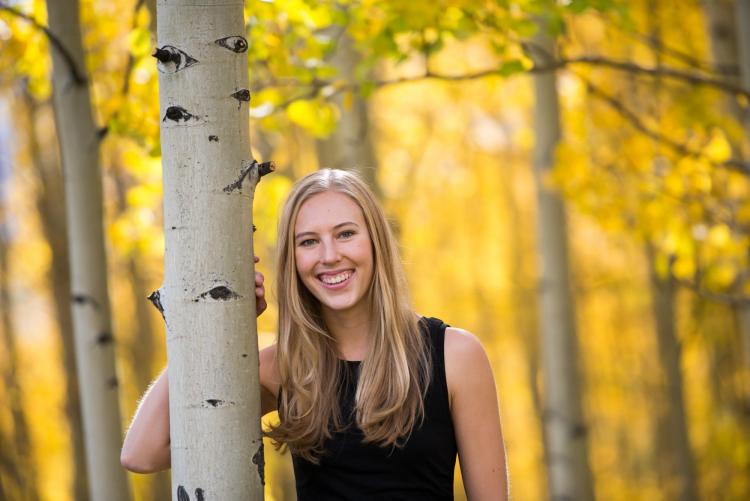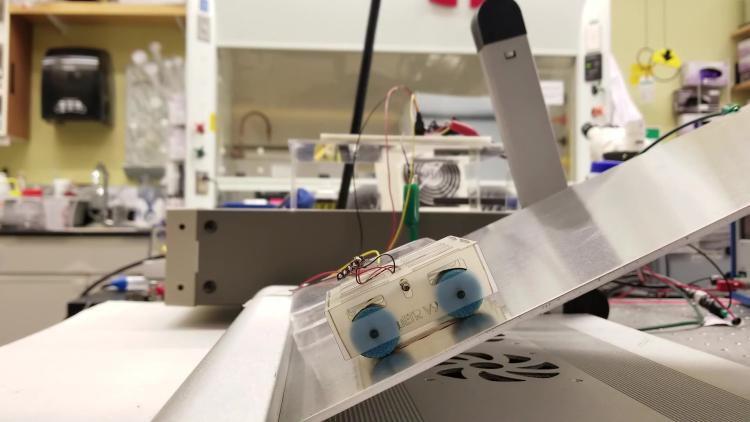The ME SPUR Experience: Evans tests a miniature tank-tread robot

Mechanical engineering undergraduate researcher, Sydney Evans.
The ME SPUR Program, modeled after CU Summer Program for Undergraduate Research, enabled undergraduate students to work with mechanical engineering faculty during summer 2020 on research that could be conducted remotely. As a participant, Sydney Evans worked with Assistant Professor Kaushik Jayaram to develop a novel robot capable of sticking to and navigating virtually any surface, leveraging adhesion mechanisms involving electrostatic attraction. The first stage of the project would involve extensive literature review, building on an existing design and developing a modeling framework for scalable fabrication. Her summer research project was titled, Miniature Tank-Tread Robot Capable of Vertical and Inverted Climbing.
Evans is a third-year student at CU Boulder studying mechanical engineering and applied mathematics. She is actively engaged on campus through the club swim team, Global Engineering RAP and as president of CU’s chapter of Engineers in Action. Her insights below provide a window into her research experience with ME SPUR.
Describe your summer research.
My research project is through the Animal Inspired Motion and Robotics Lab (AIM-RL) which was created by Professor Kaushik Jayaram. The goal of the project is to create a small robot that utilizes electroadhesion (which takes advantage of the attractive forces generated between electrically-induced opposite charges) to climb inclined conductive surfaces. This course of action will allow us to engage in the developing fields of electroadhesion and micro-robotic technologies.
This summer, my pursuit of this project involved reading a lot of literature about electroadhesion and robotics, as well as coding in Arduino and using Solidworks to make 3D models. I also designed an experimental “arena” that will be used to test the robot. I am really excited about this project, because I will continue working on it this fall as part of an independent study. This means that I will be able to follow through with my designs and code and integrate them into a functional version of the robot.
What was it like conducting research remotely?
I had a lot of opportunities to engage with the other members of my lab group; this was one component of my experience that stood out to me from the beginning. Working together and using each other’s expertise was highly encouraged by Dr. Jayaram. In one of our meetings early this summer, we did a mini-symposium within our lab so that everyone could present what they were working on, their background and experiences. I had multiple meetings with my lab members who gave me feedback and assisted with my coding and designing my testing space. While remote work was not ideal, it was well managed and now I can take advantage of the upcoming opportunity to be on campus and utilize our lab space.
What about this project was rewarding?

The miniature tank tread robot ascending an incline.
At the very beginning of this project, I was trying to practice and remember CAD, read papers and wait for Dr. Jayaram to provide instructions. One day, I read a paper about electroadhesive pad designs. I came to a section where I started jotting down questions and thoughts about the tread design of our robot. I went into my next meeting with Dr. Jayaram excited about this paper and with a lot of questions. I loved feeling like my engineering education was kicking into gear and having a real-life effect. I gained just enough confidence in myself and what I was trying to do so that when I went through all of the other difficult and daunting moments of the summer, instead of feeling like I was too inexperienced for the job, I felt as if they were normal obstacles any undergraduate engineer in research would face.
As a student new to conducting research, what skills did you bring to the project that helped you be successful?
Prior to this, I did not have any experience in engineering research. I was surprised at how often I drew on the material from my classes (I actually drew a free body diagram at one point!) such as physics, dynamics, and material science. The skills that have been most useful were Solidworks, LaTeX, and googling coding solutions and functions. These were all skills that I developed during my first two years at CU Boulder, and I don’t think my experience would have been as fun or meaningful if I had done it earlier in my career without some of these basics.
What advice would you share with other students considering getting involved in research?
Try it. I was a little intimidated and turned off by research initially, because I thought it was more about reading and writing papers and took too much time to make any interesting progress. This can be more true of research in other fields, but that shouldn’t be a reason to forego a learning experience in a research lab. Also, professors really like to share their research and are looking for students who are interested in the same things, not necessarily those who have all of the skills they need. Sitting down with a professor and hearing about their research does not obligate you to engage with it, you can walk away and find something different, or even better, have them help you connect with an alternative lab you are more interested in.

